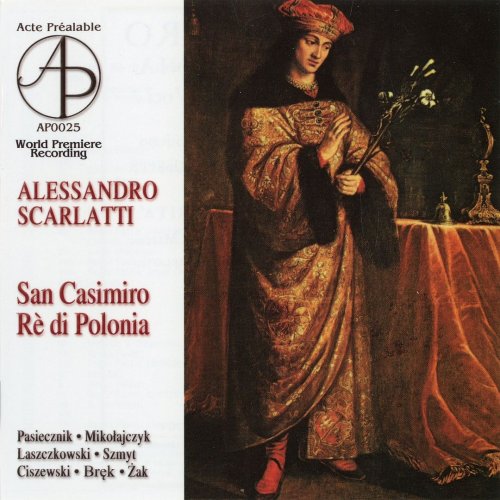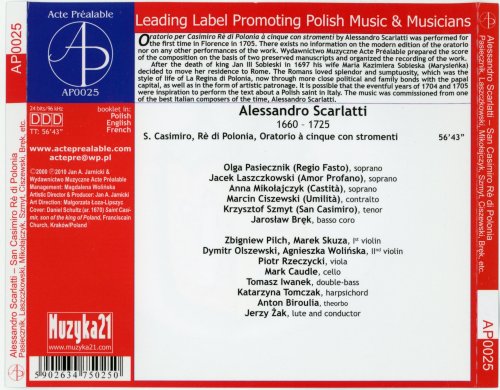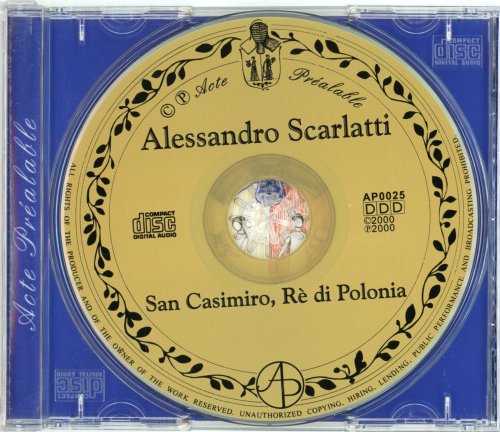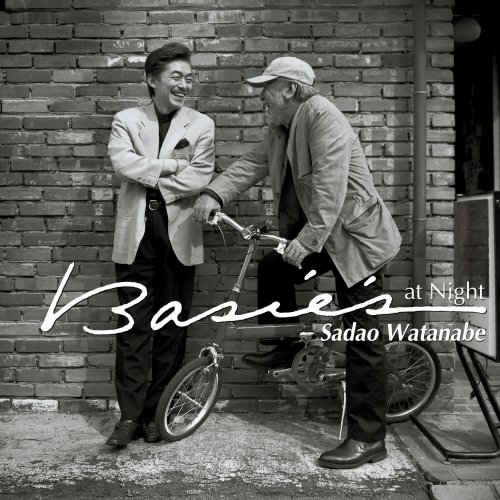Olga Pasiecznik, Instrumental ensemble, Jerzy Zak - A.Scarlatti: San Casimiro, re di Polonia (2010)

Artist: Olga Pasiecznik, Instrumental ensemble, Jerzy Zak
Title: A.Scarlatti: San Casimiro, re di Polonia
Year Of Release: 2010
Label: Acte Prealable
Genre: Classical oratorio
Quality: FLAC (image+.cue,log,scans)
Total Time: 56'43
Total Size: 251 MB
WebSite: Album Preview
Tracklist:Title: A.Scarlatti: San Casimiro, re di Polonia
Year Of Release: 2010
Label: Acte Prealable
Genre: Classical oratorio
Quality: FLAC (image+.cue,log,scans)
Total Time: 56'43
Total Size: 251 MB
WebSite: Album Preview
San Casimiro, Rè di Polonia
Prima Parte
01-18
Parte Seconda
19-32
First a necessary history lesson, in two parts, courtesy of the booklet notes provided with this world première recording of a rare oratorio by Scarlatti senior.
In 1697 King Jan III of Poland died. Attempts to install his son Jacob as King were unsuccessful and the widow of the recently deceased king, Maria Kazimiera Sobieska (also known as Marysieńka) made the decision to move to Rome. In March of 1699 she arrived there – accompanied by 259 courtiers, 30 carriages and carts, some 500 horses and a number of pack-camels! She was soon very active in the cultural life of Rome. Amongst her acquaintances was cardinal Pietro Ottoboni, a famous patron of music. Ottoboni employed Scarlatti, and was an admirer of his music - so much so that he later contributed a Latin epigraph to the composer’s tomb in Naples.
Kazimierz (the San Casimiro of this oratorio) was Prince of Poland, born in 1458. He was famous for his faith and his devotion to justice and charity. He administered the country, in the king’s absence, between 1481 and 1483 and impressed many by his obvious preference for good works over luxury and pomp. He died of illness in 1484 and was canonised in 1522. He is the patron saint of Poland.
That the exiled queen, moving in the artistic circles of Rome, should want to commission a work in celebration of her native country is not surprising; nor is it surprising that, being a friend of Ottoboni, she should turn to Alessandro Scarlatti. Scarlatti was active in Rome between 1702 and 1708. In 1703 he accepted a position at the beautiful church of Santa Maria Maggiore. What is surprising, is that the earliest known performance of San Casimiro should have been in Florence, in 1705. Maybe there was an earlier performance in Rome, of which no record has yet been found? Still, Scarlatti did have connections with Florence, where he made repeated efforts to secure employment with Prince Ferdinando de’ Medici.
San Casimiro, Rè di Polonia is a fine piece, and it is good to have this very satisfactory recording of it. Like Scarlatti’s more or less contemporary oratorio San Filippo Neri, in which the dying saint converses with personified figures of Faith, hope and Charity, San Casimiro consists of a kind of inner dialogue. In Part One, Profane Love and Royal Pomp plan to tempt Casimir towards worldly pleasures and grandeur. Chastity and Humility announce their intentions of giving Casimir their support against the temptations of Profane Love and Royal Pomp. In Part Two we meet Casimir himself for the first time. Faced with the urgings of Royal Pomp he is momentarily tempted, but with the support of Humility he resolves finally to "disdain pomp and the senses, and forget the world".
There are secco recitatives, solo arias and two duets. The tempters are generally given fast music and are often accompanied by vibrant, insistently rhythmic music. The virtues, on the other hand, generally express their views in slower more lyrical music, often in minor keys. Most of the soloists are thoroughly accomplished. The Ukrainian soprano Olga Pasiecznik is an outstanding singer, possessor of a truly lovely voice and the musical intelligence to use it well. Jacek Laszckowski shows himself a very secure counter-tenor with an attractive voice. The duet between the two, which closes Part One, is a gorgeous siciliano which is thoroughly tempting! Anna Mikolajczy has a bright, attractive voice and Marcin Ciszewski, though not blessed with the most intrinsically attractive of voices, sings his role with judgement and intelligence. In the title role, Krzysztof Szmyt is an authoritative presence, with a clear, rounded tone.
Scarlatti’s instrumental accompaniment is quite various – instruments are used in different formations and groupings. Here, the chamber orchestra under the direction of Jerzy Żak is lively, colourful and assured.
The score for this performance was prepared by Wydawnictwo Muzyczne, using manuscripts in the Vienna Osterreichische Nationalbibliothek and the Biblioteca Nacional in Madrid. For rescuing an interesting and attractive composition from oblivion he deserves our thanks – as does this very enterprising label for recording it.
Glyn Pursglove





![Milton Man Gogh - Fully Stretched (2025) [Hi-Res] Milton Man Gogh - Fully Stretched (2025) [Hi-Res]](https://www.dibpic.com/uploads/posts/2025-12/1766080588_cover.jpg)

![Cornelius Claudio Kreusch - Scoop (2025) [Hi-Res] Cornelius Claudio Kreusch - Scoop (2025) [Hi-Res]](https://www.dibpic.com/uploads/posts/2025-12/1765893706_folder.jpg)


![Dave Bainbridge - ON THE EDGE (OF WHAT COULD BE) (2025) [Hi-Res] Dave Bainbridge - ON THE EDGE (OF WHAT COULD BE) (2025) [Hi-Res]](https://img.israbox.com/img/2025-12/18/7l4en830rpyaxdtr7izc3qrx6.jpg)